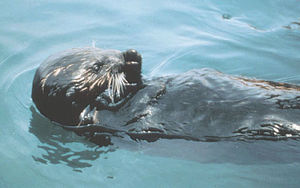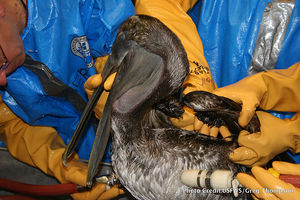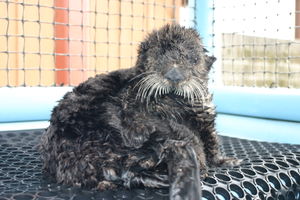Environmental impacts of oil spills
Contents
Overview
Spilled oil poses threats to freshwater and marine environments. It affects surface resources and a wide range of subsurface organisms that are linked in a complex food chain that includes human food resources. Spilled oil can harm the environment in several ways, including the physical damages that directly impact wildlife and their habitats (such as coating birds or mammals with a layer of oil), and the toxicity of the oil itself, which can poison exposed organisms. The severity of an oil spill's impact depends on a variety of factors, including the physical properties of the oil, whether oils are petroleum-based or non petroleum-based, and the ultimate fate of the spilled oil.
The various types of freshwater and marine habitats that exist in nature have different sensitivities to the harmful effects of oil contamination, as well as different abilities to recuperate. Although some organisms may be seriously injured or killed very soon after contact with the oil in a spill, other effects are more subtle and often longer lasting. For example, freshwater organisms are at risk of being smothered by oil that is carried by the current, or of being slowly poisoned by long-term exposure to oil trapped in shallow water or stream beds. In addition, oil can potentially have catastrophic effects on birds and mammals.
Sensitivity of Freshwater Habitats
Oil spills occurring in freshwaterbodies are less publicized than spills into the ocean even though freshwater oil spills are more frequent and often more destructive to the environment. Freshwater bodies are highly sensitive to [[oil spill]s] and are important to human health and the environment. They are often used for drinking water and frequently serve as nesting grounds and food sources for various freshwater organisms. All types of freshwater organisms are susceptible to the deadly effects of spilled oil, including mammals, aquatic birds, fish, insects, microorganisms, and vegetation. In addition, the effects of spilled oil on freshwater microorganisms, invertebrates, and algae tend to move up the food chain and affect other species.
Freshwater is divided into two types: standing water (lakes (Origin and age of lakes), marshes, and swamps) and flowing water (riversand streams). The effects of an oil spill on freshwater habitats varies according to the rate of water flow and the habitat's specific characteristics.
Standing water such as marshesor swamps with little water movement are likely to incur more severe impacts than flowing water because spilled oil tends to "pool" in the water and can remain there for long periods of time. In calm water conditions, the affected habitat may take years to restore. The variety of life in and around lakes has different sensitivities to [[oil spill]s].
- The bottoms of standing water bodies, which are often muddy, serve as homes to many worms, insects, and shellfish. Lake bottoms also serve has a breeding ground and food source for these organisms and higher animals. Oil in sediments may be very harmful because sediment traps the oil and affects the organisms that live in or feed off the sediments.
- In the open water, oil can be toxic to the frogs, reptiles, fish, waterfowl, and other animals that make the water their home. "Oiling" of plants and grasses that are rooted or float in the water also can occur, harming both the plants and the animals that depend on them for food and shelter. Fisheries located in freshwater also are subject to the toxic effects of oil.
- On the surface of the water, water bugs that skim the water surface and floating plants such as water lilies are threatened by oil slicks that spread across the surface.
- In the shoreline habitats of lakes and other bodies of standing water, cattails and other weeds and grasses provide many important functions for life in and around the water. They serve as food sources, nesting grounds for many types of animals, and shelter for small animals. Oil spills can coat these areas, affecting the plants and the organisms that depend on them.
- Marsh environments are among the most sensitive freshwater habitat to oil spills due to the minimal water flow. Oil spills have a widespread impact on a host of interconnected species. For example, lush marsh vegetation is used as nurseries for shellfish and fish, as a food source for many organisms, and a home for fish, birds, and mammals.
Oil spills impact flowing water less severely than standing water because the currents provide a natural cleaning mechanism. Although the effects of oil spills on river habitats may be less severe or last for a shorter amount of time than standing waters, the sensitivity of river and stream habitats is similar to that of standing water, with a few special features:
- Oil spilled into most rivers often collects along the banks, where the oil clings to plants and grasses. The animals that ingest these contaminated plants may also be affected.
- Rocks found in and around flowing water serve as homes for mosses, which are an important basic element in a freshwater habitat's food chain. Spilled oil can cover these rocks, killing the mosses and disrupting the local ecology.
Sensitivity of Marine Habitats
The marine environment is made up of complex interrelations between plant and animal species and their physical environment. Harm to the physical environment will often lead to harm for one or more species in a food chain, which may lead to damage for other species further up the chain. Where an organism spends most of its time—in open water, near coastal areas, or on the shoreline—will determine the effects an oil spill is likely to have on that organism.
In open water, marine organisms such as fish and whales have the ability to swim away from a spill by going deeper in the water or further out to sea, reducing the likelihood that they will be harmed by even a major spill. Marine animals that generally live closer to shore, such as turtles, seals, and dolphins, risk contamination by oil that washes onto beaches or by consuming oil-contaminated prey. In shallow waters, oil may harm sea grasses and kelp beds that are used for food, shelter, and nesting sites by many different species.
Spilled oil and certain cleanup operations can threaten different types of marine habitats in different ways.
- Coral reefs are important nurseries for shrimp, fish, and other animals as well as recreational attractions for divers. Coral reefs and the marine organisms that live within and around them are at risk from exposure to the toxic substances within oil as well as smothering.
- Exposed sandy, gravel or cobbled beaches are usually cleaned by manual techniques. Although oil can soak into sand and gravel, few organisms live full-time in this habitat, so the risk to animal life or the food chain is less than in other habitats, such as tidal flats.
- Sheltered beaches have very little wave action to encourage natural dispersion. If timely cleanup efforts are not begun, oil may remain stranded on these beaches for years.
- Tidal flats are broad, low-tide zones, usually containing rich plant, animal, and bird communities. Deposited oil may seep into the muddy bottoms of these flats, creating potentially harmful effects on the ecology of the area.
- Salt marshes are found in sheltered waters in cold and temperate areas. They host a variety of plant, bird, and mammal life. Marsh vegetation, especially root systems, is easily damaged by fresh light oils.
- Mangrove forests are located in tropical regions and are home to a diversity of plant and animal life. Mangrove trees have long roots, called prop roots, that stick out well above the water level and help to hold the mangrove tree in place. A coating of oil on these prop roots can be fatal to the mangrove tree, and because they grow so slowly, replacing a mangrove tree can take decades.
Sensitivity of Birds and Mammals
An oil spill can harm birds and mammals by direct physical contact, toxic contamination, and destruction of food sources. One of the more difficult aspects of oil spill response is the rescue of oiled birds and mammals.
- Physical contact - When fur or feathers come into contact with oil, they get matted down. This matting causes fur and feathers to lose their insulating properties, placing animals at risk of freezing to death. As the complex structure of the feathers that allows birds to float becomes damaged, the risk of drowning increases for birds.
- Toxic contamination - Some species are susceptible to the toxic effects of inhaled oil. Oil vapors can cause damage to an animal's central nervous system, liver, and lungs. Animals are also at risk from ingesting oil, which can reduce the animal's ability to eat or digest its food by damaging cells in the intestinal tract. Some studies show that there can be long-term reproductive problems in animals that have been exposed to oil.
- Destruction of food resources - Even species that are not directly in contact with oil can be harmed by a spill. Predators that consume contaminated prey can be exposed to oil through ingestion. Because oil contamination gives fish and other animals unpleasant tastes and smells, predators will sometimes refuse to eat their prey and may begin to starve. Sometimes, a local population of prey organisms is destroyed, leaving no food resources for predators.
Rescuing Wildlife
When an oil spill occurs, birds and marine mammals are often injured or killed by oil that pollutes their habitat. Without human intervention, many distressed birds and animals have no chance of survival. Much has been learned about the care and treatment of oiled birds and animals through experience with recent oil spill incidents. First, the need for immediate response is essential for rescuing birds and marine mammals. Second, personnel training is needed. The rehabilitation of oiled wildlife is a complex medical and technical procedure, and volunteers must be properly trained. Training workshops, which involve more than 200 hours of work, may be available through a variety of organizations such as:
- The Oiled Wildlife Care Network of UCDavis
- Tri-State Bird Rescue & Research, Inc.
- International Bird Rescue Research Center
- Save Our Seabirds, Inc.
- The California Department of Fish and Game
Third, a commitment must be made to reclaim oiled wildlife using proven, documented procedures, and avoiding shortcuts. Finally, open communication with other response agencies is crucial for any wildlife rescue operation to be successful.
Human Intervention
Many government agencies and private organizations help to rescue marine animals and birds that have been exposed to oil pollution. When an oil spill occurs, there is often a plan to help these groups cooperate to save as many animals as possible. While the government is responsible for animal rescue efforts, many private organizations assist in rescuing injured wildlife. Before any person or organization can handle or confine birds or mammals for rescue, however, they must get special permits that are issued by State and Federal officials.
If oil is spilled into a marine environment, the first step to stop the crisis is to control the release and spread of oil at its source. This prevents any additional oil exposure to wildlife and coastal areas. At the same time, efforts are made to keep animals away from possible contamination. Devices such as propane scare cans, floating dummies and helium-filled balloons are often used to scare animals, particularly birds, away from oily areas.
Rescuing and Cleaning Birds
For areas that have been polluted by oil, rescuers must capture affected birds as quickly as possible in order to save them. Once birds have been captured, they are taken immediately to treatment centers where they are given medical treatment and cleaned.
If treatment centers are not available nearby, temporary facilities must be built in local warehouses or other large buildings that offer electricity, hot water, and ventilation. The International Bird Rescue Research Center of Cordelia and San Pedro, CA, has designed a bird cleaning facility that can be operated from a trailer, so that a truck can bring the facility to the scene of an accident quickly.
Minimizing stress is critical for ensuring that captured birds survive. Rescue parties usually will contact rehabilitation workers even before they arrive, to make sure that they are prepared to care for the captured birds immediately. This ensures that the birds are treated as quickly as possible.
Once a bird has been brought to a rehabilitation center, basic procedures are followed. First, oil is flushed from its eyes and intestines. Heavily oiled birds are wiped with absorbent cloths to remove patches of oil. Rehabilitation workers also conduct an initial examination to detect broken bones, cuts, or other injuries. Stomach-coating medicines may be administered orally to prevent additional absorption of oil inside the bird's stomach. The bird is then warmed and placed in a quiet area. Curtains are often hung around the area to limit the bird's contact with people.
Nutrition is essential for the recovery of oiled birds. Wild birds will generally learn to feed themselves from pans or other containers as soon as they begin to feel healthy. In many cases, however, the birds must be force-fed until they are able to feed on their own.
After a bird is alert, responsive, and stable, and its body's fluid balance restored to normal, detergent is gently stroked into its feathers to remove the oil. An oiled bird may require three or more washings to remove the oil entirely.
After its feathers are completely rinsed, the bird is placed in a clean holding pen lined with sheets or towels. The pen is warmed with heat lamps, and surrounded with curtains to minimize human contact. If behavior appears normal and a bird's condition remains stable, it is allowed to swim. The bird then begins to preen and realign its feathers to restore them to their original structure, helping the bird to become waterproof again.
Before a bird can be released, it must "pass" the waterproofing test. That is, it must demonstrate buoyancy (the ability to float) and water-repellency (the ability to keep water away from its body). Once a bird passes the test, it is slowly exposed to temperatures comparable to outside weather. Its weight and muscle structure should be average for its species, and it should show no signs of disease. Rehabilitated birds are banded by the U.S. Fish and Wildlife Service , and are released early in the day to an appropriate habitat.
Marine Mammal Rescue and Cleaning
Two primary groups of marine animals may be affected during an oil spill. The first group, pinnipeds, includes animals such as walruses, harbor seals, and sea lions. These animals are quite large, and rely on blubber under their skin to stay warm. Harbor seal mothers give birth on isolated beaches and small rocky islands. Newborn pups are not yet protected by a layer or blubber, and do not enter the water until a few days after birth. Some scientists are concerned that when a seal pup's protective fur coat becomes oiled, its warming qualities are reduced, increasing the likelihood of death from exposure. When these animals are seriously distressed, they are handled by marine mammal stranding networks, such as the Marine Mammal Center in San Francisco, California.
The second group of fur-bearing marine mammals includes sea otters and fur seals. These animals do not have a layer of blubber, but instead rely on their thick fur coats to maintain warmth. If the coat becomes dirty through contact with oil or other polluting substances, its protection may be lost, and the animal will become chilled in icy waters. Sea otters, in particular, groom themselves extensively and are at risk from swallowing toxins.
The Hubbs Research Center, in San Diego, California, specializes in mammal rescue efforts. The Center employs experienced animal handlers to ensure the best treatment of stricken animals. Other animal welfare organizations, such as Friends of the Sea Otter and local Societies for the Prevention of Cruelty to Animals, provide marine mammal rehabilitation sites.
Specific techniques are employed by the Hubbs Center and other organizations to help oiled marine mammals to recover. After an animal is captured and transported to a marine rehabilitation facility, it is checked for hypothermia and dehydration, then prepared for cleaning. The otter is lightly sedated during the washing process, which is usually done by a team of two workers. One restrains the animal and the other washes it with a mild detergent. Once rinsed, the otter is hand-rubbed with towels and dried with hand dryers. Through its natural grooming process, the otter preens itself, distributing an oil-like fluid produced by glands in its skin. In about seven days, the otter's fur will regain its water-repellency.
During the recuperation process, an otter's body temperature and eating habits are monitored. It is fed a variety of its favorite foods, including fish, squid, shrimp, and scallops. As its health improves, the animal is moved to a holding tank. Slowly, it is introduced to its natural habitat. Often, an otter will try to return to a habitat that is still contaminated. For this reason, released otters are tagged with tracking devices. Some are held for longer periods of time in order to give cleanup crews additional time to remove more oil from the area.
After the Exxon Valdez oil spill on March 24, 1989, otter rehabilitation and pre-release centers were built in Valdez, Seward, and Homer, Alaska. These facilities remained in operation until September 1989. The three centers treated a total of 357 otters and released 197 into Prince William Sound and along the Kenai Peninsula. Because of concerns for their health, an additional 24 adult otters were sent to various seaquariums. In addition, 13 otter pups, most of which were born in captivity, were transferred to seaquariums because they were too young to be released.





